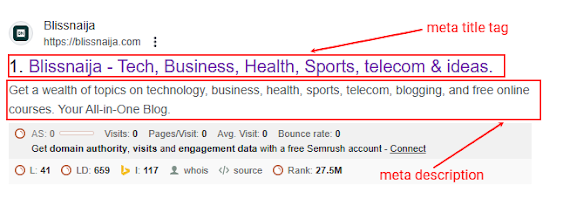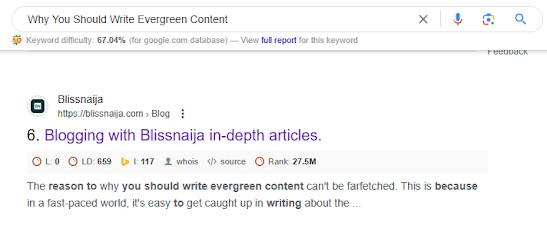Title Tags & Meta Descriptions Optimization: Best Practices for Improved SEO
Title tags and meta descriptions optimization of a website or webpage is the process of crafting or updating already crafted tags or descriptions to standard so as to enable search engines to understand what the site or website is all about.
Key Takeaways
- Understand how crucial title tags and meta descriptions are for improving a webpage's visibility
- Guidelines and best practices for optimizing title tags include using relevant keywords, creating unique and concise titles, and avoiding keyword stuffing.
- Best practices for optimizing meta descriptions include creating compelling and concise descriptions, using relevant keywords, and avoiding duplicate content.
What is a title tag?
A title tag is a crucial on-page search engine optimization(SEO) element that specifies the title of a webpage. Title tags form part of snippets displayed on the SERPs to provide a descriptive summary when a researcher queries for a particular term or phrase. A title tag is displayed also in the browser title bar when the page is viewed in the browser. Optimizing the title tag of a webpage is critical for the ranking of such a webpage.
What is the importance of a title tag?
A title tag is very important because it gives a direct description of the content of a webpage to the search engines and also the users and in a way helps in improving how relevant the page is. This also helps in increasing the click-through rate (CTR) of the page.
Title tags are the gateway to search engines understanding what a webpage is all about. By so doing, they improve the ranking of the webpage. They are not a major factor in webpages ranking but they play a very crucial role.
Optimizing Title Tags
In order to ensure a created title tag has the quality it desires in making a user click, you have to take the following components into consideration:
- Keywords: The relevant keywords ranked on that page should be included in the title tag. Don't overdo it.
- Relevance: The created title tag should also be relevant to the webpage or website content. That is it should reflect what the page is all about.
- Clarity: Everything about your title tags should always be clear and very easy to understand.
- Readability: Always write your title tags in clear language and they should be capitalized.
- Length: Title tags should not be too long or too short. Since the meta title length is between 200px and 571px, the recommended maximum character length should be from 30 - 60 characters.
What is a meta description?
A meta description is also an element which also provides brief, concise and accurate information on what a webpage is all about. It gives the summary of a webpage. it also forms part of the snippet played on the search engine result pages(SERPs) for particular search queries. It is also critical in improving your website click-through rate and in a way increasing your traffic because it helps the researcher determine whether a webpage is relevant to his or her search before deciding to click on it.
Are Meta descriptions important for SEO?
Title tag and meta description optimization is a very important SEO activity which is carried out in order to help in the improvement of webpage visibility and also attract researchers to click the webpage link.
A well-crafted title tag and meta description(meta tags) increase a web page's click-through rate and the engagement of users with such a webpage. They are also there to convey the page's content to all search engines for better search engine results.
Optimizing Meta Descriptions
Incorporating Keywords
Ideal Length
Call to Action Inclusion
Always make sure you include a call to action (CTA) within your meta description so as to help entice researchers to click and visit the webpage. Action-oriented languages like "Enroll Now", and "Learn More" could be used appropriately. Make sure the CTAs are relevant to the content of the webpage.
Common Mistakes in Optimization
When optimizing title tags and meta descriptions, there are several common mistakes that can negatively impact search engine rankings and user experience. Here are two of the most common mistakes to avoid:
Keyword Stuffing
Keyword stuffing is the practice of repeating the same keyword or phrase multiple times in a title tag or meta description in an attempt to manipulate search engine rankings. Not only is this a black hat SEO technique that can result in penalties, but it can also make the content appear spammy and unappealing to users.
Instead, focus on creating unique and descriptive title tags and meta descriptions that accurately reflect the content on the page. Use variations of the target keyword or phrase, but don't overdo it. Aim for a natural-sounding title tag and meta description that entices users to click through to the page.
Duplicate Tags & Descriptions
Another common mistake is using duplicate title tags and meta descriptions across multiple pages. This can confuse search engines and make it difficult for them to determine which page is the most relevant for a given search query.
To avoid this mistake, create unique title tags and meta descriptions for each page on your website. Use descriptive language that accurately reflects the content on the page and includes relevant keywords where appropriate.
By avoiding these common mistakes, you can improve your website's search engine rankings and provide a better user experience for your audience.
Measuring the Effectiveness of Optimization
After optimizing title tags and meta descriptions, it is important to measure the effectiveness of the changes made. This section will cover two key metrics to track: click-through rate and website ranking.
Click-Through Rate
Click-through rate (CTR) is the percentage of users who click on a search engine result page (SERP) link after seeing it. A higher CTR indicates that the title tag and meta description are compelling and relevant to the user's search query.
To measure CTR, webmasters can use Google Search Console. In the Performance report, select the Pages tab to see the CTR for each page. By comparing the CTR before and after optimization, webmasters can determine if the changes made to the title tags and meta descriptions have improved the page's visibility in search results.
Website Ranking
Website ranking is the position of a website in search engine results for a specific keyword or phrase. A higher ranking indicates that the website is more visible to users searching for that keyword or phrase.
To measure website ranking, webmasters can use tools such as Google Analytics or SEMrush. These tools provide insights into the website's ranking for specific keywords and phrases. By monitoring the website's ranking before and after optimization, webmasters can determine if the changes made to the title tags and meta descriptions have improved the website's visibility in search results.
It is important to note that optimizing title tags and meta descriptions is just one aspect of SEO. Other factors such as quality content, mobile-friendliness, and website speed also contribute to a website's visibility in search results. Therefore, it is recommended to track multiple metrics and continuously improve the website's overall SEO strategy.
Don't forget to leave a comment, tell me where you are not cleared or what is your confusion if there is any. I shall give a clarification immediately.
If you wish to implement the best SEO strategy on your blog or website but lack the technical know-how, do connect me through:
Let's Connect!
Frequently Asked Questions
What is the purpose of optimizing title tags and meta descriptions?
Optimizing title tags and meta descriptions helps search engines and users understand the content of a webpage. When done correctly, it can improve the visibility of a website in search results and increase click-through rates.
How long should a meta title be?
A meta title should be no more than 60 characters long. This ensures that the entire title is visible in search results and doesn't get cut off.
What are some best practices for writing meta descriptions?
Some best practices for writing meta descriptions include keeping them under 155 characters, including the primary keyword, and writing a unique description for each page. It's also important to make the description compelling and informative to entice users to click through to the page.
Why are title tags and meta descriptions important for SEO?
Title tags and meta descriptions are important for SEO because they provide valuable information to search engines about the content of a webpage. This information helps search engines determine the relevance of a page to a search query, which in turn affects its ranking in search results.
What are some tools for optimizing title tags and meta descriptions?
There are many tools available for optimizing title tags and meta descriptions, including Yoast SEO, Moz, and SEMrush. These tools can help analyze existing tags and provide recommendations for improvement.
How can I analyze and improve my existing title tags and meta descriptions?
To analyze and improve existing title tags and meta descriptions, start by conducting a site audit to identify any issues. From there, you can use tools like Google Search Console or SEMrush to monitor performance and make adjustments as needed. It's also important to regularly review and update tags and descriptions to ensure they remain relevant and effective.
Labels: meta description, on-page seo, SEO, title tag







